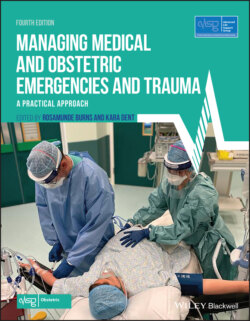Читать книгу Managing Medical and Obstetric Emergencies and Trauma - Группа авторов - Страница 126
Box 6.1 Management of anaphylactic shock
ОглавлениеStop administration of drug(s)/blood product likely to have caused anaphylaxis
Resuscitation as for any collapse following ABC principles with reassessment
The key treatment therapies are oxygen, adrenaline and fluids. Adrenaline is very effective and should be given as early as possible
Cardiopulmonary resuscitation (CPR) should be considered when systolic blood pressure is <50 mmHg or the patient is in cardiac arrest
Source: Adapted from AAGBI (Association of Anaesthetists of Great Britain and Ireland). Quick Reference Handbook 3‐1 Anaphylaxis, 2019
Treatment of anaphylactic shock (Box 6.1) is as follows:
1 Call for help and note the time.
2 Call for cardiac arrest trolley, anaphylaxis treatment and investigation pack (should be in theatre recovery – familiarise where it is kept in your unit).
3 Remove all potential causative agents.
4 Manual uterine displacement.
5 Open and maintain airway. Give high‐flow/100% oxygen and ensure adequate ventilation. Intubation may be required for severe stridor or cardiorespiratory collapse.
6 Elevate the legs if there is hypotension.
7 If systolic blood pressure is <50 mmHg or there is cardiac arrest start CPR.
8 Give drugs to treat hypotension:Adrenaline 0.5 mg (0.5 ml of 1:1000) intramuscularly every 5 minutes until there is improvement in the pulse and blood pressure. Intravenous adrenaline may be used by experienced (anaesthetic) staff in a monitored patient in 50 microgram boluses (0.5 ml of 1:10 000) titrated against response.If intravenous access proves difficult obtain intraosseous access. Hypotension may be resistant and require prolonged treatment.Consider starting an adrenaline infusion after three boluses: 5 mg in 500 ml dextrose (1:100 000) titrated to effect, or 3 mg in 50 ml 0.9% saline started at 3 ml/h (= 3 micrograms/min) titrated to maximum of 40 ml/h (40 micrograms/min).Glucagon 1 mg repeated as necessary in beta‐blocked patient unresponsive to adrenaline.If hypotension resistant give alternate vasopressor: metaraminol, noradrenaline or vasopressin.
9 Intravascular volume expansion with crystalloid 20 ml/kg: initial bolus repeated until hypotension is resolved.
10 Other drugs that can be given:Hydrocortisone 200 mg intravenously.Chlorphenamine 10 mg intravenously.
11 If there is persistent bronchospasm despite an adequate dose of adrenaline to stabilise the blood pressure, consider bronchodilators, e.g.:Salbutamol 5 mg via oxygen‐driven nebuliser, or 250 micrograms diluted intravenous slow bolus.Magnesium sulphate 2 g intravenously over 20 minutes.Aminophylline 5 mg/kg intravenously over 20 minutes if not already taking theophylline.
12 Check fetal heart and continuously monitor by cardiotocography. If in cardiac arrest, perform perimortem section. If not in cardiac arrest, consider timing and method of delivery once maternal status is stabilised.
13 Take a 5–10 ml clotted blood sample for serum tryptase as soon as the patient is stable. Plan for repeat sample at 1–2 hours and >24 hours.
14 Plan to insert arterial and central venous pressure lines and transfer the patient to a critical care area.
15 Prevent readministration of possible trigger agents (allergy band, update notes and drug chart, liaise with anaphylaxis lead regarding ongoing investigation and referral (www.bsaci.org) to identify causative agent). Inform the patient, obstetric consultant and GP and report to the Medicines and Healthcare products Regulatory Agency (MHRA, www.mhra.gov.uk/yellowcard).
